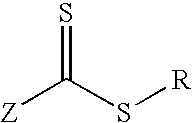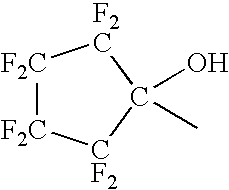Low-polydispersity photoimageable polymers and photoresists and processes for microlithography
- Summary
- Abstract
- Description
- Claims
- Application Information
AI Technical Summary
Benefits of technology
Problems solved by technology
Method used
Image
Examples
example 1
Synthesis of a TFE, NB—F—OH, HAdA, PinAc Tetrapolymer
[0150] A metal pressure vessel of approximate 270 mL capacity was charged with 52.2 g NB—F—OH, 12.38 g PinAc, 10.66 g HAdA, 3.18 g of S-cyanomethyl-S-dodecyltrithiocarbonate and 15 mL of ethyl acetate. The vessel was closed, cooled to about −15° C., and pressurized to 400 psi with nitrogen and vented several times. The reactor contents at about atmospheric pressure were heated to 75° C. TFE was added to a total pressure of 180 psi and a pressure regulator was set to maintain the pressure at 180 psi throughout the polymerization by adding TFE as required. 100 ml of a monomer feed solution was prepared by combining 24.17 g NB—F—OH, 34.4 g PinAc and 29.6 g HAdA in ethyl acetate. The solution so prepared was pumped into the reactor at a rate of 0.10 mL / minute for 12 hr. Simultaneously, a solution of 2.89 g Vazo®67 diluted to 100 mL with ethyl acetate was pumped into the reactor at a rate of 2.0 mL / minute for 6 minutes, and then at a ...
example 2
Synthesis of a TFE, NB—F—OH, HAdA, PinAc Tetrapolymer
[0152] The procedure of example 1 was followed except that the 3.18 g of S-cyanomethyl-S-dodecyltrithiocarbonate was replaced by 3.87 g of 4-cyano-4-(dodecylsulfanylthiocarbonyl)sulfanyl pentanoic acid. There was isolated 82.1 g of polymer. GPC analysis showed Mn=6700, Mw=13400, Mw / Mn=2.00. Anal. Found: C, 58.95; H, 7.78; F, 10.82.
example 3
Synthesis of a TFE, NB—F—OH, HAdA, PinAc Tetrapolymer
[0153] The procedure of example 1 was followed except that the amount of S-cyanomethyl-S-dodecyltrithiocarbonate was increased to 4.77 g and the amount of Vazo®67 was increased to 4.40 g. There was isolated 80.5 g of polymer. GPC analysis showed Mn=6200, Mw=11100 and Mw / Mn=1.80. Anal. Found: C, 59.83; H, 7.71; F, 10.33. From its 13C NMR spectrum, the polymer composition was found to be 3% TFE, 21% NB—F—OH, 45% PinAc and 27% HAdA.
PUM
| Property | Measurement | Unit |
|---|---|---|
| Polydispersity index | aaaaa | aaaaa |
Abstract
Description
Claims
Application Information
 Login to View More
Login to View More - R&D
- Intellectual Property
- Life Sciences
- Materials
- Tech Scout
- Unparalleled Data Quality
- Higher Quality Content
- 60% Fewer Hallucinations
Browse by: Latest US Patents, China's latest patents, Technical Efficacy Thesaurus, Application Domain, Technology Topic, Popular Technical Reports.
© 2025 PatSnap. All rights reserved.Legal|Privacy policy|Modern Slavery Act Transparency Statement|Sitemap|About US| Contact US: help@patsnap.com



